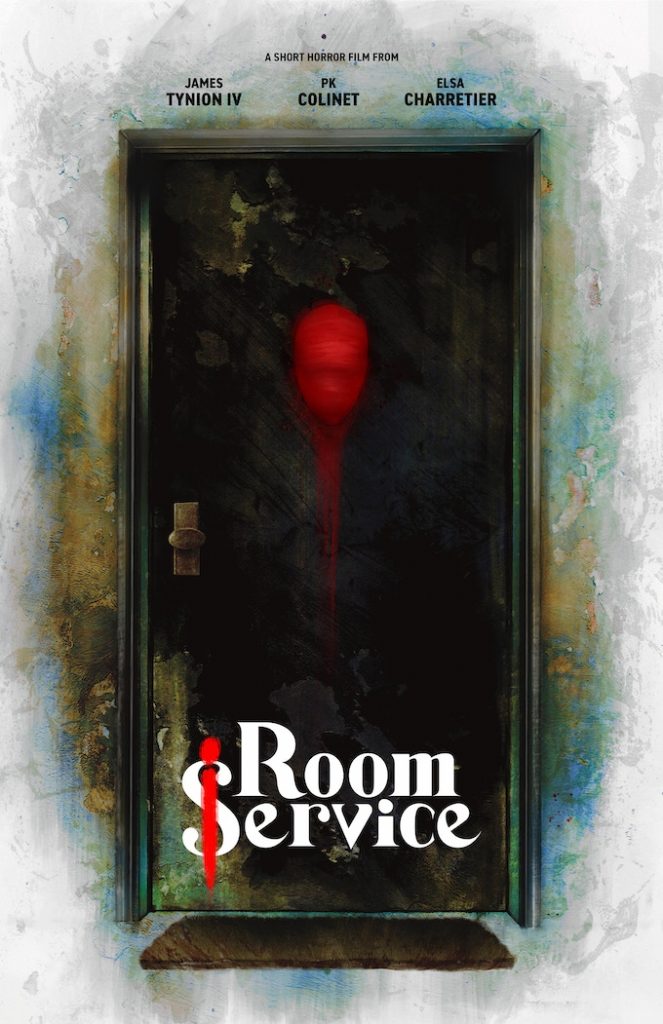“It Just Sounded Like a Lot of Fun”: Elsa Charretier, James Tynion IV, and PK Colinet on Kickstarting ‘Room Service’
Elsa Charretier, James Tynion IV, and PK Colinet are comic creators first and foremost, but they’re also true hyphenates. They’re people who are always looking for ways to push their skills and footprints as storytellers and individuals, which is part of the reason they’re thriving as much as they are. That said, some things are even unexpected for them. Case in point: That trio is making a short horror film together called “Room Service,” and they’re funding it through Kickstarter, with a chance of it being expanded to a feature film later, per the Hollywood Reporter piece announcing the project.
It’s a big swing even for this group of risk-takers, but it finds each operating in familiar territory, with Tynion scripting the film, Charretier drawing the storyboards, and Colinet directing it, as well as other collaborators like artist Martin Simmonds drawing the film’s poster and the genius that is Tonči Zonjić designing a key character’s mask in the Caretaker. You might be wondering what it’s about? Well, here it is, straight from the Kickstarter page.
“We live in a world where everything is for sale, for the right price. Where the wealthy know there is no desire outside the reach of their wallet. ‘Room Service’ is a brutal glimpse inside that world. Our protagonist is down on his luck, his family is on the verge of ruin, and with the help of the mysterious Caretaker, he might have found a way out of his trouble. But at what cost?”
You might have other questions beyond its plot. I certainly did. So earlier this week, I had the opportunity to sit down with Charretier, Tynion, and Colinet on Zoom to discuss why and how this project came together, and their overall approach to making a film after years of comic making both together and individually. You can find that interview in full below, with slight edits for both length and clarity.
This is open to non-subscribers, but if you enjoy this chat, please consider subscribing to SKTCHD for more interviews and features like this.
I don’t remember which of you told me this, but James or Elsa, one of you told me before that you two were working together on something. And shockingly, in my head, it was of course going to be a comic. (Tynion laughs)
It is not.
There are a lot of places we could start, but I want to start with the why of it all. You all are obviously rather busy and could really do anything you want to some degree. Why did you want to make a short film together instead of a comic?
PK: It’s my fault, actually. Well, it started when we were recording the second Kickstarter video, I realized how much I missed doing short movies. I did a lot of short movies when I was a kid and doing this video, one with a bit more narrative, really brought back some memories.
So it created an itch. (laughs) That’s when I asked Elsa to start the YouTube channel with me because I really missed doing videos. And the more videos we were producing, the more I felt we needed to do a bigger thing, a real movie.
Elsa: With a story.
PK: A real story. (laughs) And that’s how it started. I just kept telling myself “I need to do it now and just, like, I can’t wait anymore.”
Elsa: And then he enrolled me. (laughs) Well, we have a thing when one of us wants to do something, the other one just cannot say no. It’s an unspoken agreement.
PK: That’s how we started doing comics, right?
Elsa: That’s how we started comics. He needed an artist. I was a failed actress. And he asked, “Do you think you can learn how to draw because I need to turn in a pitch and I don’t have an artist.” (laughs) And so I was like, “Okay, I’ll do it.” And that’s how it started. And then the same for this movie. Although I will not be acting in this movie, I want to make sure that people understand that. (laughs)
James: Maybe we make that one of the stretch goals. (laughs)
Ooh.
Elsa: Oh my god. No, no, no. (laughs)
That’s actually a pretty good idea. I’m not going to lie.
Elsa: I would do a cameo. That’s how far I would go.
James: There we go.
Elsa: So yeah, I could see this coming. When we started doing the YouTube channel, I could see that light that he had whenever he had a camera in his hand back then, because I’ve known PK for so long that I actually knew him when he was doing short films as a kid, as a kid myself acting in those movies. And I could see that itch was not going to go away until he finally said, “I want to do a short film. How can we do this?” And that’s how we thought about James.
James: For me, so much of the answer, to reveal too much about my psychology, is a little bit to do with spite and a chip on my shoulder. Last year I finally stepped away from DC in a big way, but that was happening around the same time as I was making my first awkward forays into the full-on Hollywood space and adapting some of my own material.
But I like just going and making things when there’s a creative urge to bring something to life in a new form. I don’t like having to work through the system to do it. So honestly, when the email came through that PK and Elsa were looking for a collaborator to do something, to make a short horror film and that we were going to try to fund it ourselves and all of that, it just sounded like a lot of fun.
And it sounded like a way for me to find myself in this medium, in a way that I didn’t see. I could take the 10-year path again like I did through DC comics and kind of find my voice through a corporate system. Or I could just follow my own instincts, work with talented collaborators whose work and vision I really trusted and try to bring something to life. And so that’s what appealed to me more than anything.
I just want to comment on how different the levels of big swings you three are taking versus mine. For example, last week I sent an email to somebody where I was like, “This is a big swing. I want to set up an interview with this creator.” And PK and Elsa, your big swing was emailing arguably the busiest human being on the planet to say, “Do you want to make a movie that we Kickstart together?” (laughs) That is such a big swing. I respect the hell out of it.
Elsa: Well, there’s one thing that, as someone working out of spite myself, (laughs) I am familiar with that and I know how to bring people like that in. So I just say, “So we’re thinking of something a bit crazy, you might not have the time, but how about we be the first to do this?”
And I just knew that James would be in. (laughs)
You could have done this a lot of different ways. You’re all notable storytellers in your own regard. I’m sure you could have found funding if you really wanted to. But you’re also no strangers to crowdfunding in a wide variety of ways. I mean, you have done Kickstarters, everyone’s on Substack, Elsa you have a Patreon. This is obviously considerably different than your typical comic book project. Why did you want to go with Kickstarter? Was it just because it was your best path to funding without sacrificing your collective creative vision on it?
PK: At first I was thinking of financing it all myself with our company. That’s why I asked James to write a version that would be cheaper to shoot, actually. Then when I got the script, it was so good and so intense, and it was everything I’d wanted to do for so long that I shouldn’t do it for $20 or $30,000.
I needed to do it the right way. To find $100,000, you have to go to a real production company with a lot of strings attached. And that’s why we decided to go directly to Kickstarter.
Elsa: And also it takes time. You have to submit pitches, you have to wait for approval, then you get notes, then you get script notes, then you get production notes and all that can take a long, long time.
We cannot wait. James is the same. He just said, “Whenever we have an idea, we just have to do it right now.”
James: To add on to that, it’s like we’re existing in this bizarre world right now where all these major film production companies are having huge turnovers of staff. There’s weird mergers and all sorts of instability in the Hollywood space.
There’s a chance that if we had tried to get this lined up at a major studio six months ago, the people who would’ve helped us line that up might not still be at that company anymore. Especially for a project like this, where we’ve all got something to prove. We’re all trying to say, “Hey, we have honed our crafts in these other spaces and now we’re going to come in and show you how we’ve honed our craft and do something really special.”
And that would’ve required a leap of faith. It would’ve required more extra hand-holding and a lot of politics and all of this stuff. Or we could turn to our fan bases and say, “Hey, this is really important to us. We know we can do this well and we just need your help to make it happen.”
Elsa: Yeah, absolutely. And there’s also a component of excitement that you get through Kickstarter that fuels you during whatever project you end up having to complete. And for something this ambitious, that new to us, that level of excitement from backers is a drive plus when you have to create something that’s hard.
Yeah, I think it creates an area of effect too. When all of your fans start getting excited, but then it starts spilling out. You become a Project We Love on Kickstarter and next thing you know it kind of reaches a critical mass that makes it bigger than you could have expected. That’s one of the amazing things about doing an ideal version of crowdfunding. I know that there’s a lot of times where it’s just a stress ball of pure anxiety, but in this case I think you’ll probably do fairly well.
But I did want to ask about where you’re at in…I hesitate to say, in production because it’s obviously still a ways down the line. The Kickstarter will have barely even launched by the time this interview publishes. But you said that you read James’s script. How many of the production details have you figured out? Do you know, generally speaking, where you’ll shoot, how you’ll shoot, who will be in it, besides Elsa obviously? Or does that come later when you determine how much budget you have to work with?
PK: Yeah, it’ll come later. That’s a weird process. It’s a bit backwards. Usually, we have to figure out how we are going to shoot after we determine the budget.
Elsa: How much money we get will dictate what kind of gear we can rent, whether we have to do it with our own gear, how many shooting days we get, the actors we can get. All of that will highly depend on what the Kickstarter earns. If we get a crazy high end goal, we can turn to big actors. That would be a game changer. So all of that is going to be determined after the fact. Although that’s kind of weird to say. What we do know is that it’s going to be a fairly simple movie to shoot. It happens over the course of a single evening. It happens in a single room with only three actors. So the basics of the movie are going to be that.
PK: So we planned everything we could plan for. The storyboards are completely done, the script is done.
Elsa: The thing is, we could shoot this with $20,000 or $100,000. It would just look different. But it could happen with different sorts of budgets.
James: And just to add to that, I wrote the script in the early part of this year. About six months ago is when I knocked out the first draft. And so we’ve been able to kick it around and tinker with it. And there’s a first round of storyboarding based on that. So we have the rough composition of what the film will be. And then it’s using the budget to fine tune the details of the execution.
So you’re pretty far down the path already. That’s always the fear with Kickstarters, or at least it was back in the day. “If I back this thing, will it happen?” And film productions are obviously a completely different animal than making a comic because it seems much larger conceptually. With yours, the nice thing is you’re going to be able to say that we have the script, we have storyboards, we have a path. Then how big and how significant and how impactful this could be depends on your support effectively. Is that kind of how it works?
PK: Yes.
Nice. I did want to ask about the concept of Room Service itself. I have to admit, I know very little about it. I know it involves a character named the Caretaker. I know the genius that is Tonči Zonjić designed that character’s mask. Let’s break into that really quick. How did you get him on board?
Elsa: Here’s the secret. When you want to work with talented people, you email them. (laughs)
You’re describing my entire journalistic career. (laughs)
Elsa: If you come in with a very earnest ask and something that will titillate their imagination, they will say yes. It’s foolproof. It always works. See! We got James! (laughs)
That’s how you do it. I’ve been a huge fan of Tonči’s for a long, long time. And I bought the omnibus for all of Lobster Johnson a few months ago. I was like, “I need to somehow work with this man sooner rather than later.”
PK: And we were fans of him for his work on Star Wars. Absolutely amazing.
Elsa: Going back to what you were saying about the Caretaker, who is one of the main figures of the film, we knew that this was going to be the point of entry for viewers, but also for backers. So the design, how it would look…because it would be pretty much the only thing that we would be able to talk about during the Kickstarter, it had to have a huge impact visually. And so that’s where Tonči came in.
He is unbelievable. If anything comes from this, I hope everyone just ends up buying all of his work because it’s absolutely amazing.
But tying into that though, the project is Room Service. It’s a horror short film in which James, you’re writing, PK you’re directing, Elsa you’re doing storyboards. Obviously there’s some level of delineation between roles. But in terms of the concept itself, were there discussions between the three of you about what the core idea was before James scripted it?
PK: We only discussed themes and mood, as well as some films I really like. But I trusted him with everything he wanted to do.
James: Honestly, it was a really incredible process. There are a few different ways that I come to a new story. A lot of times I’ve just been thinking about a bunch of raw pieces and then an opportunity strikes where I might be able to put a new project into the world and suddenly five pieces that were in separate boxes before come together in my head and I see them as the final product.
And this is one of those moments where, once we started talking about what we would want to accomplish with this, the kind of limitations of, we’re not going to be able to build an entire Nice House on the Lake. (David laughs) This is something where we needed something contained. Those sorts of rules are really creatively fertile ground to start putting the pieces together. And I think you’re going to see this in a lot of my next generation of work…one thing that I’ve been deeply fascinated by is the secret economy that exists for the ultra-wealthy in the world. I think it’s absolutely horrifying what exists out there and what exists just behind the curtain from the rest of society. So I wanted to do a story that tapped into that.
The other thing that I do in a lot of my creator owned projects is, I love thinking about what the key visual is. What is the singular image of the story or the character that sort of embodies what the entire book is. Like Erica Slaughter embodies everything that Something Is Killing the Children is about. The Fictional Woman embodies everything that the Department of Truth is about.
So for this, I wanted to craft it around this kind of faceless Caretaker, who is this horrifying figure who is enabling some very dark things to happen, and is clearly a part of this whole larger system and all that. There’s a lot of mystery around this character. But this Caretaker was the horror image of this story.
And once we started talking about that and fleshing him out and then beyond that, once Tonči’s designs came in, it was just absolutely thrilling because I think he completely nailed the feel of the character that we wanted.
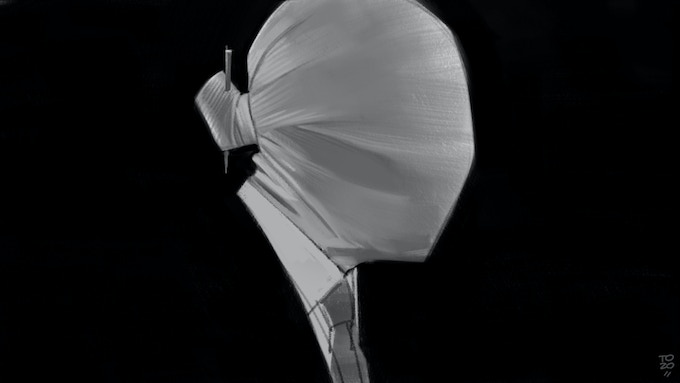
This makes me a little surprised that you all aren’t doing the Caretaker’s mask as a reward you could get. (laughs) You did that for Erica Slaughter, right? Where you had the mask created as merch, right?
James: Yes we did. But I think the Caretaker mask is something that would need…it’s more how you pin it back. And that’s something that I’m not sure we could offer.
That’s a stretch project on your stretch goal.
James: Yeah.
I did want to ask about something in specific for you, James. Horror is obviously a genre that’s working in today’s larger film industry. It’s one of the few original spaces that’s thriving these days. I’ve always suspected it’s mostly because it’s uniquely inexpensive to make quite often and it makes a lot of money because people love being afraid. It’s also something you’re very good at. Going into Room Service, was there any part of you that wanted to deliberately differentiate this story from what else is out there? Or is it just about leaning into what’s right for the story?
James: I think the story will stand on its own two legs as its own distinct piece. But I think the real thing that’s always driving me is; what am I interested in and how do I wrestle that interest out of my brain and onto the page. And so really, I am extremely lucky at this moment in my career that the sorts of stories that I am most interested in telling have a strong commercial value. I am making the most out of this moment because I know the pendulum swings will go through another horror desert in another few years where there won’t be a lot of horror movies or there won’t be a lot of horror comics. There will always be some, but this is the way that it always happens.
And right now, the ground is fertile for a lot of incredible horror stories. And I am making the most of it because these are the stories I love telling the most.
So PK and Elsa, I had a question about the visuals. Listening to you all talk about it, Room Service sounds like, as an outsider, that it is so contained it could almost be a play. It’s a single room, it’s just a few actors. You already thought about it from a storyboard standpoint. Have you started thinking about how you visually distinguish this in a way that makes it necessary for it to be a film rather than a play or a comic or a prose novel or whatever?
PK: I think it needs to be a movie because we need to be in control of what we show and how long we show something. You know what I mean? In a comic, you can choose how long you look at a panel, how long you stay on a page. And for this story the rhythm and tempo are very important, and the tension you build while maintaining a shot is major. So it only works as a movie because it was really written to be a movie.
Elsa: I totally agree with you. I think camera movements too, and I can speak to it because I had to draw them. I had to figure out how to draw a camera movement. I actually didn’t know how to do it, so I had to learn. The way that we collaborated on the storyboards was…PK is a very visual director. He knew what he wanted in terms of camera movement.
I am not sure if this falls under the storyboard artist control. I don’t know how it usually works. But the way we did it is that I was basically there to translate visually his very rough stick figures and the mood and the tone of camera movements. And the way the camera moves within the different sequences is a wonderful addition to James’ script.
PK: It adds to the storytelling and the narrative and what you want to say.
Elsa: Camera movements are a huge part of the subtext that you can do in movies. So yeah, that’s another level of reading that you wouldn’t have gotten if we were to do this at a play or as a comic. We would’ve done it differently. It’s a different sort of storytelling. But the way it is now is because it’s a movie.
PK: And also thanks to James’ scripts, I can finally work on something that I’ve really missed: sound design. I don’t want to spoil anything, but there are a lot of elements of sound design here. Like a lot. Rhythms and beats…but I can’t say more. (laughs) That’s something I missed a lot when I was writing comics. The sound, even though we have sound effects, it’s not the same in terms of how you set the mood with music and how you can trick the viewer with a sound.
I have to admit, as a big movie buff myself, my first question in my head was like, “I wonder who they’re going to get to score it?” Is it going to be you, PK? Are you going to do the music?
PK: No…
Elsa: He’s as good a composer as I am an actor. (laughs)
I do want to talk about the intersection of your existing audiences, because I was trying to think of others in comics who have taken their existing popularity in that medium and used it to fund something in a completely different one. And I came up with exactly one person: Spike Trotman with Lackadaisy from Iron Circus. She funded an animated film on there and that was not something she’d ever done before. And it did really well. You have one, James?
James: Yeah, Meredith Gran made the jump over into video games.
Oh, there we go. So, two. We got two. The point is this is uncommon.
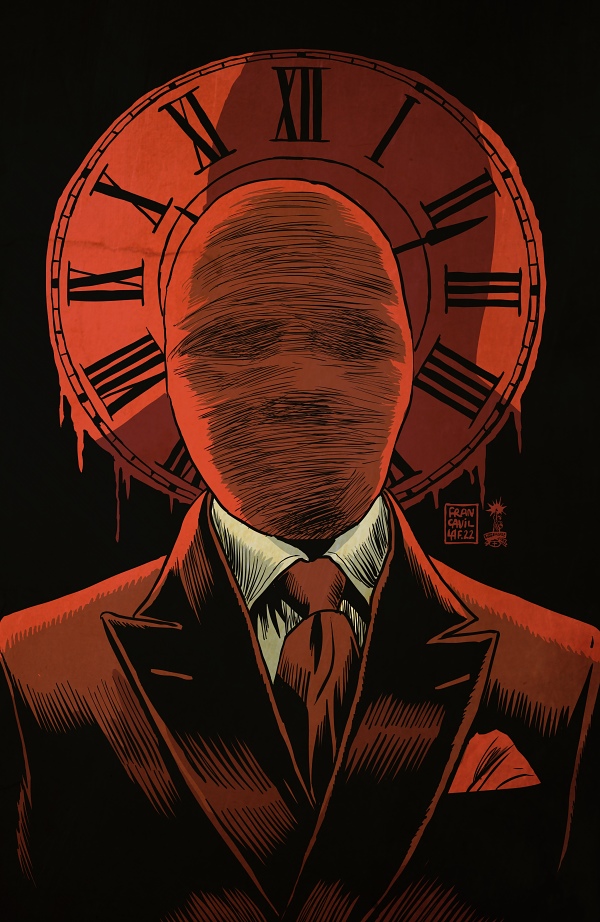
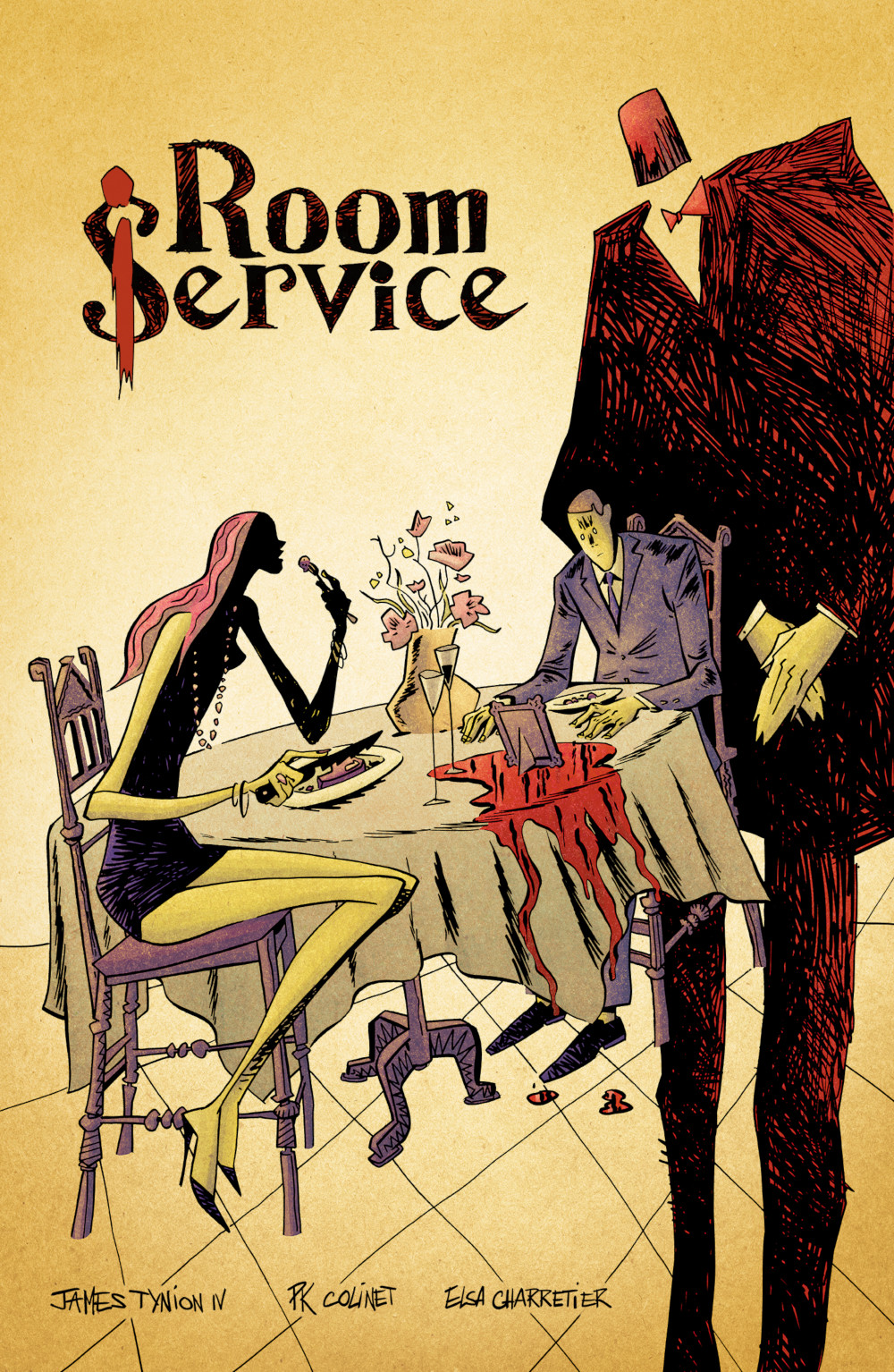
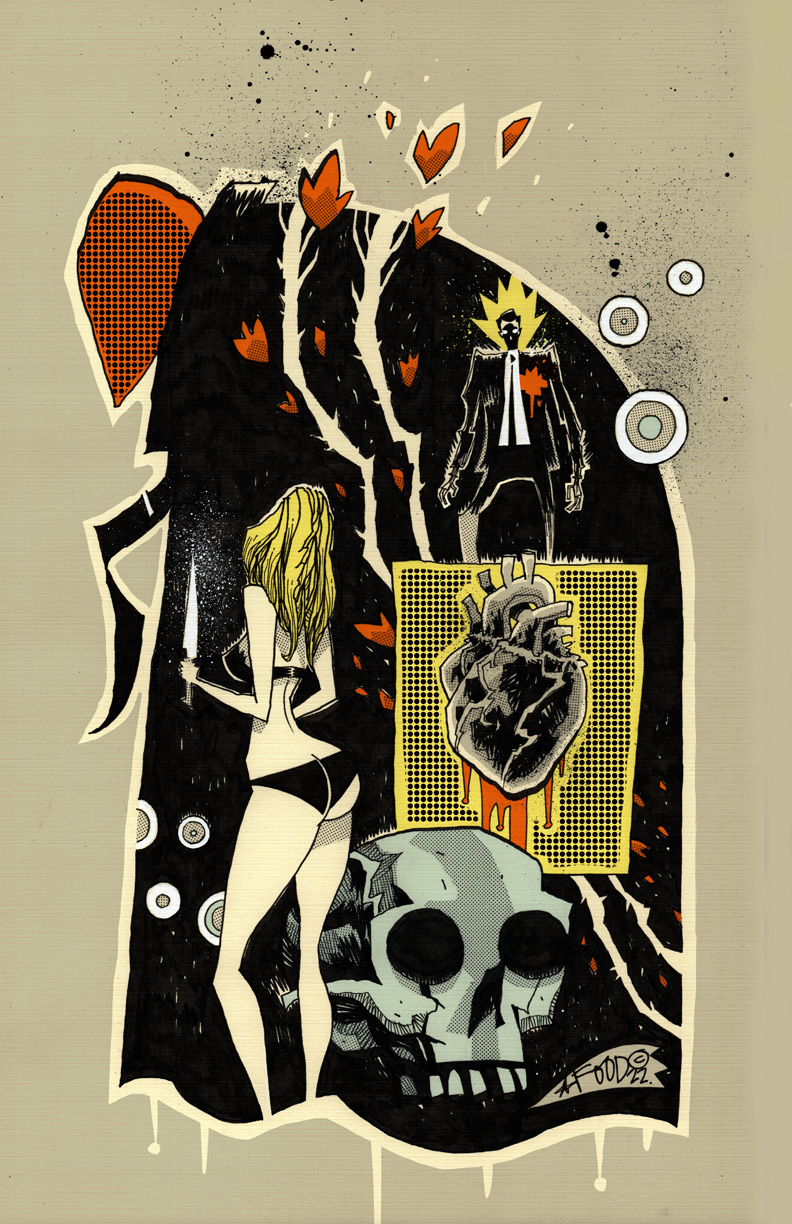
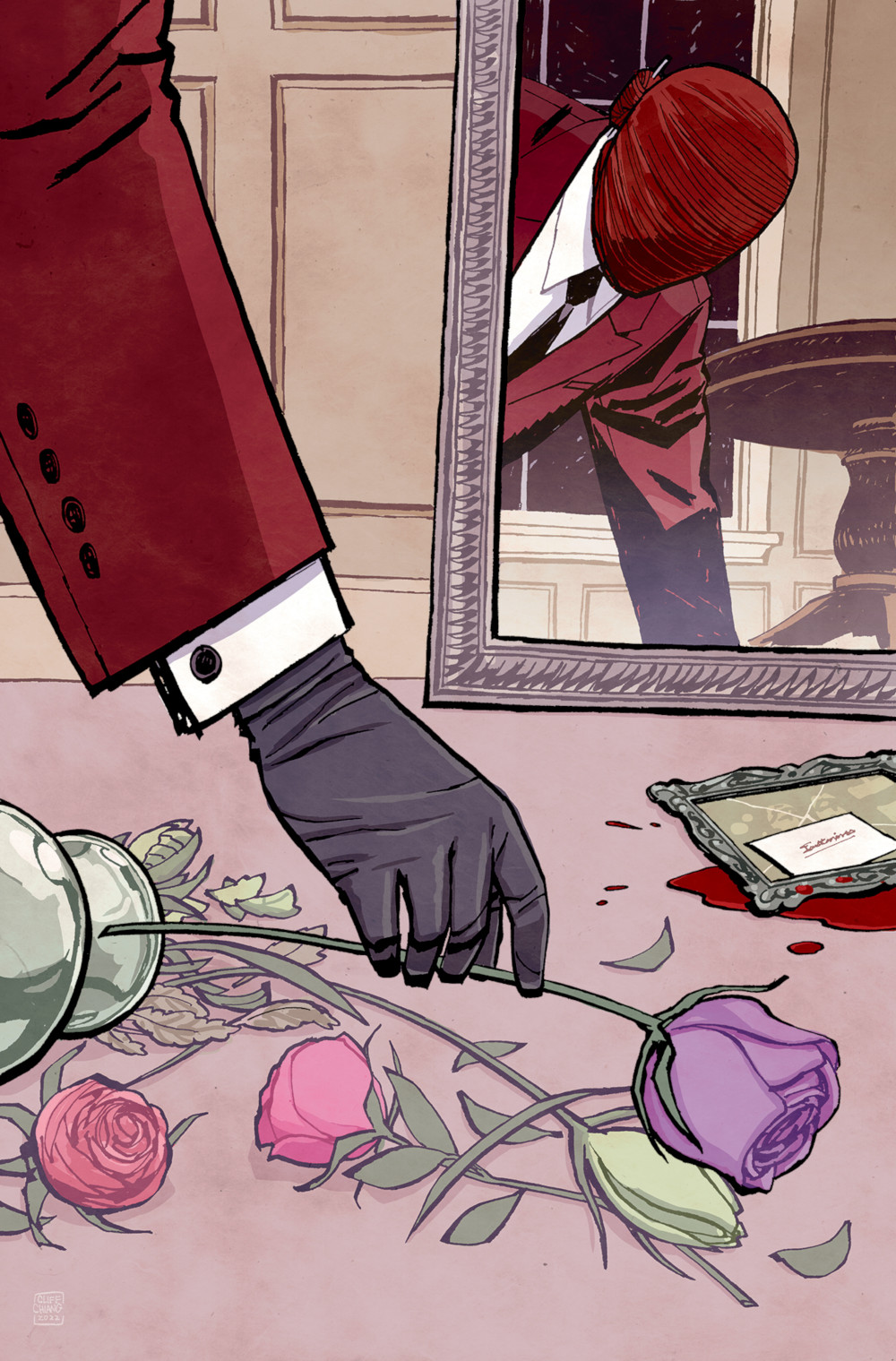
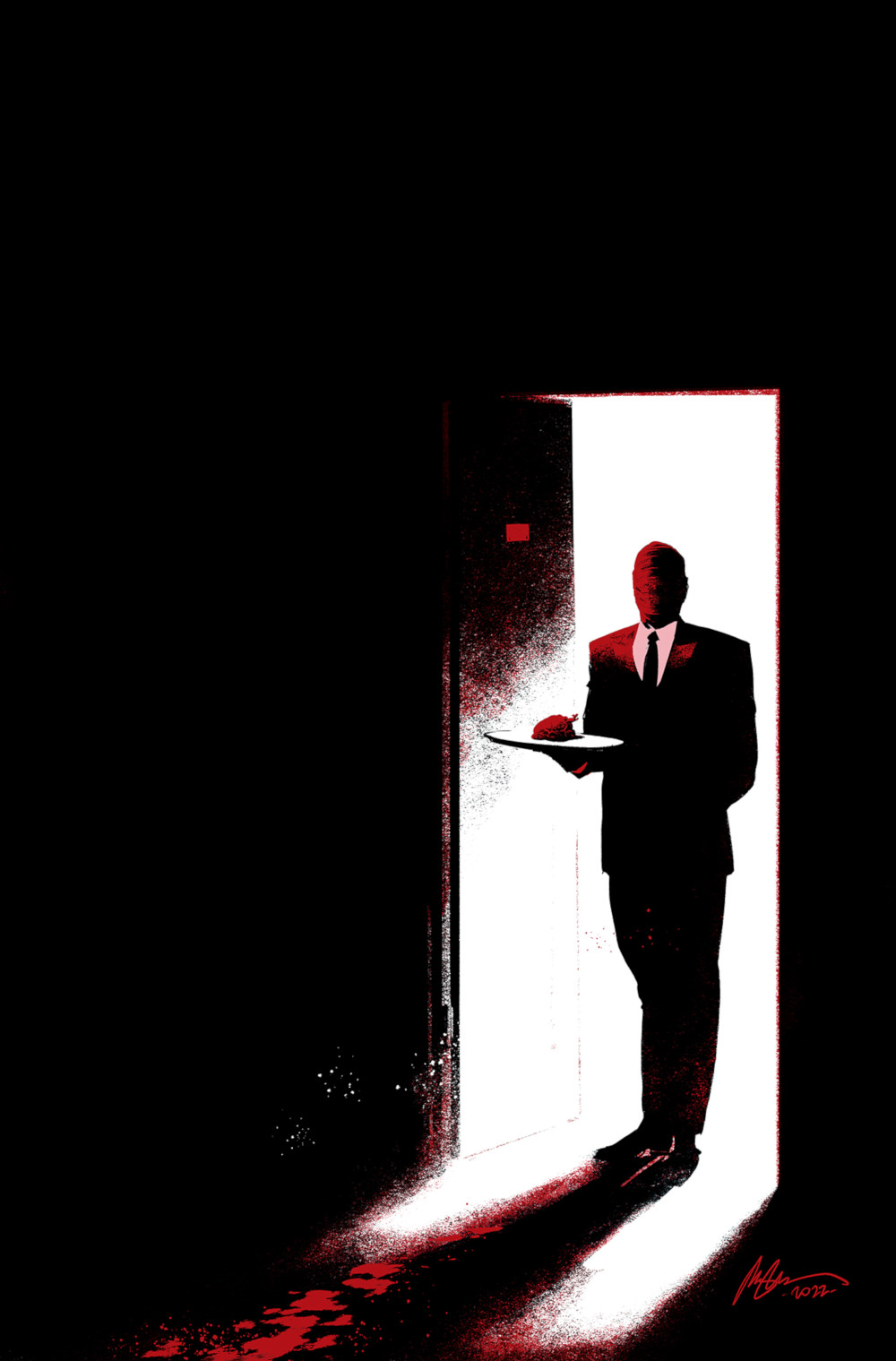
It seems like a lot of what you’re doing, and this might be me looking way too deep into your rewards, a lot of what you’re doing with your rewards appears to be designed to connect it back to comics in a way, with a poster from Martin Simmonds, an art book documenting the film’s creation, an illustrated version of the prose story, prints from Rafael Albuquerque, Cliff Chiang, Francesco Francavilla, Jim Mahfood and you, Elsa.
So, there are a lot of…not comic specific rewards, but comic adjacent rewards. 1 Was part of your design for your rewards, to some degree, to connect them to the language your readers speak already because they’re maybe coming from a comic perspective to some degree?
Elsa: I would like to think that it was a sort of master plan to bring in both audiences. (laughs) It’s just what felt natural.
PK: These are the rewards that we love to get when we back something, actually. We didn’t want to just ask for the money. We really want to give something in return that is beautiful. And we love doing beautiful books, beautiful prints.
Elsa: One of the reasons we used Kickstarter in the first place was books. So we had to find a way to somehow produce a book and we made this art book that is going to be gorgeous. But I think there’s also the fact that there’s a tremendous level of overlap between comic book fans and film fans. So I think that the rewards that we’re putting out can appeal to both audiences. And the idea was to do sort of a hybrid campaign. If you look at movie Kickstarters, a lot of the stretch goals for examples, are “Added a day for shooting,” or “We get a stuntman,” or that sort of stuff that add on to the final product of the film. And that’s great.
But I think that we instinctively understood that it wouldn’t be a huge draw to comic book fans. So the idea was to do something in-between. We haven’t launched yet, so we’ll see. But I’m pretty confident that people are going to be excited about what we’re offering.
James: One thing that we spent a lot of time talking about right at the start of the process is they put out this amazing book of the storyboards for Parasite by Bong Joon-Ho. And that was the model that we were talking about. A growing section of my bookshelf are fascinating film art books that are being put out now. A24 does these amazing coffee table books, all of this stuff where I think people are starting to realize, especially in a world where we don’t have the Blu-ray sets and all of that anymore, that having a physical totem of your love and appreciation of a film is still very valuable.
And finding new and interesting ways to tap into that is, as a film nerd, that’s what I want. So when we started talking about doing something like this, it was just like, “Yes, this is exactly the sort of thing I want to do.”
And then I think you hit the nail on the head. This is us speaking in the language that we typically speak to our audiences with, where it’s just like, “You want to get a pretty book that is full of words and pictures. We’ve got one for you.” (laughs)
Elsa: Somehow I was like, “Yeah, we’re going to do a movie. But what about the art book though? How many artists are we going to hire to do a deluxe print set?” All that stuff. It’s so exciting to do. I should also add that the full movie storyboards are going to be in the movie artbook too.
Isn’t one of the tiers that you’re selling the original storyboards also?
Elsa: Yes. Individual frames are available as original art in the Kickstarter.
James, I’m right there with you with those fancy movie books. We’re kind of secretly living in this age where there’s an unbelievable amount of access to books and tomes that are made that celebrate film in interesting ways. The other day I bought the oral history of Mad Max: Fury Road. I didn’t even know that that existed. And I am absolutely thrilled about getting to read that.
But in terms of the rewards you’re doing, there’s a lot of overlap when it comes to how you approached these rewards and your rewards for your art book Kickstarter, Elsa.
Elsa: I’m a one trick pony, that’s all I do. (laughs)
I wouldn’t say that, because there’s also all the other rewards, the behind the scenes, production material, that you’re doing. Those are going to speak to fans of film in their language. And I think that that’s the way that you really make your audience bigger is by approaching both sides and going there together.
Last question. Do you have a sense for the roadmap to this film actually being produced?
Elsa: Sure. Like we said earlier, this is all going to depend on the budget that we get in the end. So we have decided on a very wide schedule to make sure that if we can go really big with this, we still deliver on time. The delivery time is September 2023. So almost a year from now. Of course, our goal is to have it done before then. We’d rather be a couple months earlier than a couple months past the deadline. It’s a bit up in the air for now, but no later than September 2023.
Well, I mean once you reach the backing levels you hope to reach, you’re going to have to start dealing with A-list actor schedules.
Elsa: It’s the same for the crew. If you want a famous director of photography, you have to work with their schedule too.
But whatever production ends up looking like, we are very generous users of Kickstarter updates. (laughs) We try to never leave people in the dark. Backers always know where we’re standing at. So yeah, there’s going to be a big level of communication from us.
James: I think that this is part of why I’m happy to be working with Elsa and PK. They’ve actually gone through the Kickstarter process before and successfully fulfilled multiple Kickstarters. They are good at keeping the audience updated. If I was doing this by myself, I’d just be guessing my way through it.
Elsa: That’s not true though. You would do it fine by yourself. We’re happy that you’re doing your first Kickstarter with us. But you know that you would.
Thanks for reading this interview with the team behind the horror short film, Room Service. If you enjoyed this chat, consider subscribing to SKTCHD for more like it.
Editor’s note: This apparently includes a comic book as well, which was announced after this was posted.↩

